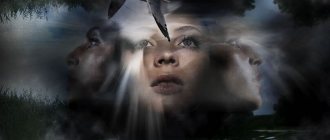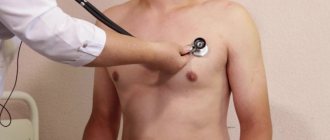Signs of vegetative-vascular dystonia are varied, in most cases they are a consequence of neurosis. VSD and neurosis are concomitant disorders; in addition, patients with VSD may experience mental disorders. Complex therapy allows you to eliminate the physiological and mental manifestations of the disease.
Effective treatment of neuroses and mental disorders in VSD is carried out by neurologists, psychotherapists, exercise therapy instructors and other specialists at the Yusupov Hospital, who use sound and safe methods of therapy.
VSD: astheno-neurotic syndrome
Modern experts believe that vegetative-vascular dystonia occurs as a result of stressful influences, as a result of which the functioning of the body’s systems is disrupted. Many people believe that neurosis and VSD are the same thing, but this opinion is erroneous. Various types of neuroses are common disorders that accompany VSD. However, most often when examining patients, astheno-neurotic syndrome is revealed.
When the nervous system is depleted in a person, astheno-neurotic syndrome is formed, the main manifestations of which are:
- emotional instability;
- high fatigue, which occurs even with minimal loads;
- drowsiness;
- feeling of weakness;
- cardiopalmus;
- trembling in the body.
Modern specialists use effective methods to restore normal functioning of the nervous system and neutralize the manifestations of VSD. When patients present with signs of impairment, the attending physician prescribes a comprehensive diagnosis to determine the degree of clinical manifestations and causes of the impairment. Based on the diagnostic results, methods are determined that need to be used as part of complex therapy.
The specialists at the Yusupov Hospital treat every patient with care. The coordinated work of the medical staff and other employees of the Yusupov Hospital is aimed at providing quality services in conditions of increased comfort.
Diagnostics
Despite the large number of symptoms, recognizing autonomic neurosis and starting its treatment is quite difficult. The doctor conducting the study must very accurately determine which organs or systems suffer most from neurosis. If you suspect the presence of this disease, the doctor should additionally conduct research for other diseases to make sure that they are not the cause of the detected symptoms.
How to treat vegetoneurosis? Treatment of autonomic neurosis is carried out mainly without the use of drugs. First of all, the functioning of the autonomic nervous system itself should be normalized, and then all accompanying symptoms will disappear. To achieve this, the doctor and the patient need to jointly develop a daily routine with sufficient hours for rest. Adequate sleep, proper nutrition and avoidance of stress are required.
High results are achieved with sanatorium-resort treatment, when a person is protected from life’s problems and concentrates only on recovery and relaxation. Moderate physical activity also has a beneficial effect on health. A set of physical therapy exercises and regular walks in the fresh air have a beneficial effect on the autonomic nervous system.
In addition to rest and peace, a course of psychotherapy is recommended for treatment for patients with autonomic neurosis. Several sessions of communication with a doctor help a person get rid of internal tension and feel light and free. It is very important that the psychotherapist fights not only the consequences of neurosis, but also finds out and eliminates the causes of its occurrence. However, no matter how good a doctor is, his efforts must be supported by the desire of the patient himself. If a person is not internally inclined to treat autonomic neurosis, all measures may be useless.
If we talk about the treatment of autonomic neurosis with medications, then the doctor can prescribe painkillers and sedatives that are not addictive. Also, sometimes the patient is prescribed to use sleeping pills for proper rest and medications that directly affect the autonomic nervous system. Medicines are not always used to treat autonomic neurosis; the need for their use and dosage is determined by the doctor.
Derealization in VSD
VSD and mental disorders can manifest themselves against the background of mental trauma, strong experiences and physical and nervous exhaustion. Some patients with VSD develop signs of mental disorders that do not allow them to lead a full life.
The feeling of unreality of what is happening during VSD or derealization is the brain’s reaction to stress. With this disorder, a person perceives the world around him as distant and unreal.
This disorder is different from panic attacks. The main signs of derealization are:
- perception of reality as unreal;
- changes in the perception of sounds, colors;
- feeling of weakness;
- increased blood pressure;
- fear of madness.
Against the background of these symptoms, the patient maintains adequate behavior and controls his actions. If signs of derealization appear, you must immediately consult your doctor who will prescribe treatment.
When treating derealization, it is necessary to get rid of bad habits and optimize time for rest and work. At the Yusupov Hospital, experienced psychotherapists interact with patients who have a feeling of unreality of what is happening with VSD, who use safe methods to eliminate depression and other manifestations of the disorder.
Reasons for appearance
The main causes are diseases of the nervous system and spine. In particular, with VSD and neurosis, the characteristics of a panic attack. And osteochondrosis and panic attacks are inseparable. The first diagnosis is one of the reasons for the second. Due to the fact that there is constriction of the vessels that feed the human brain, dizziness and darkening in the eyes appear. As a result, a feeling of fear and helplessness arises. These symptoms cause the heart to beat faster, which is a sign of VSD.
Besides this, there are other factors. Among them:
- mental trauma;
- unhealthy lifestyle: drinking alcohol, smoking and using drugs;
- fatigue, which causes the body to require more rest;
- strong emotional and mental stress;
- heredity. People whose relatives suffered from neurosis or VSD are approximately 20% more likely to have this disease than others;
- constant stress and emotional turmoil: conflicts at work, school, scandals in the family;
- weakness in the body, which enters the chronic stage. Also, VSD and neurosis appear with severe exhaustion of the body.
VSD with agoraphobia
Fears and panic attacks during VSD occur suddenly in patients. Agoraphobia is one of the defense mechanisms that manifests itself unconsciously. This condition is characterized by a person’s avoidance of open spaces. Experiences arise as a result of traumatic situations that are associated with surrounding people.
The development of agoraphobia is influenced by bad habits, mental illness, trauma received in childhood, and bad habits. The main symptoms of agoraphobia are:
- shallow breathing;
- cardiopalmus;
- tinnitus;
- skin redness;
- intense sweating;
- fear that people around will notice the attack;
- feeling of embarrassment;
- fear of going crazy;
- fear of death.
Patients come to the Yusupov Hospital who say that they seem to be going crazy from VSD; they have read reviews about this disorder online and thereby independently aggravate their condition. Agoraphobia also causes behavioral symptoms. The patient begins to avoid environments or circumstances that cause fear. He becomes more confident when surrounded by close people, for example, when going to the store with a relative.
Agoraphobia with VSD is treated at the Yusupov Hospital through regular sessions with a psychotherapist and taking medications. For drug treatment, tranquilizers and antidepressants are prescribed. These drugs have side effects, psychotherapists at the Yusupov Hospital select the safest drugs for patients.
Symptoms of autonomic dystonia syndrome
Symptoms of SVD directly depend on which system or organ is affected. The disease leads to dysfunction of body systems. According to the nature of the course in children, the following deviations are distinguished:
Vagotonia is a disorder of the nervous system, which is manifested by acrocyanosis of the feet and hands. This pathology is manifested by blueness of the extremities. The reason for this is the extremely slow flow of blood to the extremities through small vessels. Other symptoms of SVD include acne, hyperhidrosis, as well as allergies and swelling under the eyes. In the case of a depressive disorder of the nervous system, the skin becomes cold, dry and quite pale, the vascular network becomes unexpressed. In some cases, an eczematous rash and itching may be noticed.
A characteristic disorder is a clear violation of thermoregulation: poor tolerance of frost, wet weather, drafts, as well as constant chills and chilliness.
Children with vegetative dystonia syndrome often complain of poor functioning of the gastrointestinal tract. Nausea, abdominal pain, vomiting, heartburn, diarrhea or, conversely, prolonged constipation, pain behind the sternum, a lump in the throat - a common occurrence with SVD. The cause of these disorders is contraction of the muscles of the esophagus and pharynx. Depending on the age of the child, the most popular symptoms of vegetative dystonia syndrome are: pain in the abdominal area - 6-12 years; periodic vomiting – 3-8 years; diarrhea and constipation – 1-3 years; colic and regurgitation - up to 1 year.
SVD is most clearly represented by dysfunction of the cardiovascular system. This condition is called neurocirculatory dystonia. With this disease, there can be a huge number of cardiac dysfunctions, the most popular of which are associated with conduction and heart rhythm disturbances. Traditionally, cardiac dysfunction includes:
Extrasystole is a contraction of the heart before the set time. Among all arrhythmias, children's extrasystole is a noticeable leader: about 75% of cases are due to this particular disorder. With extrasystole, patients complain of headache, irritability, dizziness, excessive fatigue, and so on. In parallel with this, other diseases and abnormalities arise: high meteotropicity, weather dependence, as well as vestibulopathy. Patients quickly get tired under stress, their performance is at a very low level.
Paroxysmal tachycardia is an extremely sudden symptom. Without adequate reasons, the child’s heart begins to beat much faster. This can last either several hours or a couple of seconds. Most often, children with high initial tone and mild or acute insufficiency of the sympathetic department become victims of paroxysmal tachycardia as a consequence of autonomic dystonia syndrome.
Mitral valve prolapse is often combined with stigmata of dysembryogenesis (minor developmental anomalies). Most often, this indicates some kind of inferiority of vegetative dystonia, as well as connective tissue.
Autonomic dystonia in combination with arterial hypertension is characterized by an increase in blood pressure. This is a fairly popular deviation, which often develops into hypertension of various degrees. The symptoms of this deviation are as follows: memory impairment, cardialgia, irritability, excessive fatigue, dizziness and frequent headaches. As for the headache, it affects the occipito-parietal or occipital zone and has a monotonous pressing character. It appears after waking up or during the day and can intensify after certain loads. Often, another symptom is added to headaches - nausea, but it does not come to vomiting.
Autonomic dystonia, combined with arterial hypertension, manifests itself already at 7-9 years of age. As a rule, it affects pulse pressure, which drops to 30-35 mmHg. Headaches associated with this disease can be easily dulled with a break from study or rest from physical activity, good healthy sleep, and walking in the fresh air.
With this disease, there is a deterioration in the physical development of children. The degree of this lag depends solely on the degree of the disease itself. Most often, children suffering from vegetative dystonia with arterial hypertension have pale skin, red dermographism and a pronounced vascular network.
Does psychotherapy help with VSD?
A psychotherapist for VSD affects the psycho-emotional sphere using various methods. In most cases, after treatment for neuroses and psychological disorders associated with VSD, complete recovery occurs. During sessions, psychotherapists teach techniques to curb the manifestation of derealization and agoraphobia.
Psychotherapists use structured techniques to help relieve the patient from the manifestation of these disorders. During sessions, the patient can trust the specialist and talk about his experiences. If you need advice from a psychotherapist or other clinic specialists on the treatment and diagnosis of VSD and its manifestations, make an appointment by calling the Yusupov Hospital.










